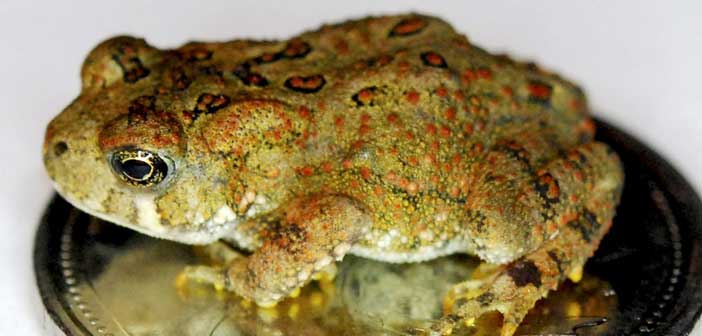MANITOULIN—American toads are having a banner year around Batman’s Campground near Sheguiandah. For the past three weeks, hundreds of small versions of the toad, called toadlets, have been hopping around the lawns and woods of the campground to the delight of children.
The American toad is the only species of toad (its scientific name is Anaxyrus americanus) found on Manitoulin Island. When full grown, it is a large, squat toad with brown, reddish or olive skin and dark blotches containing one to two spots of various colours. People cannot get warts from touching toads. In fact, the bumps on the skin of toads are not warts.
Toads eat insects and small creatures that live in soil, such as worms and slugs. They can shoot out their sticky tongues to catch prey. Each American toad can eat up to 1,000 insects every day so they are widely considered friends to gardeners and farmers.
Toads require habitats with semi-permanent ponds or slow moving streams in which to lay their eggs. Eggs are laid in long strings of clear sticky gel and hatch into immatures called tadpoles that swim about aquatic habitats grazing on algae.
Tadpoles change into small toads a few weeks later and disperse away from the water. Their thick skin helps prevent dehydration and allows them to use drier habitats than would be suitable for frogs.
They also require dense patches of vegetation, for cover and hunting grounds. Given these two things and a supply of insects for food, American toads can live almost everywhere on Manitoulin Island, ranging from forests, farmers’ fields, to backyards. During daylight hours they seek cover under boardwalks and porches, dead leaves, flat stones, logs and wood piles. During the winter they hibernate on land and burrow beneath the frost line in the soil.
There are two strategies used by frogs and toads for becoming adults. One strategy used by frogs is for the tadpole to be the major part of the frog’s increase in size. The other strategy, the one practiced by American toads, is for the terrestrial stage of life, not the aquatic tadpole stage, to be the major period of growth.
American toads are unusual compared to frogs in that the newly transformed toadlets are tiny compared to the size of adults. Toadlets start off 0.8 to 1.3 cm in length when they leave aquatic habitats then slowly grow into adults up to 10 cm in length in terrestrial habitats.
Tadpoles of the American toad usually change into toadlets in synchrony with thousands coming out within a few days. This is a strategy for increasing their chances of survival and is common for creatures such as midges and mayflies that get heavily preyed upon at a specific stage of their life cycle. Garter snakes often gather around ponds and gorge themselves on toadlets as they emerge from the water. When tadpoles change into toadlets and leave the water all at once, predators can’t eat them all, and some escape to grow into adult toads.
However, toads counteract their predators with poison glands in the skin on their backs that make most animals reluctant to eat them. Dogs that pick up a toad will drop it and may foam at the mouth, but the dog will not be hurt. Garter snakes and some other predators are immune to this toxin. The toxin is harmless to curious campers who enjoy picking up the cute critters for a closer look. Even so, it is best to wash your hands after handling toads, and of course, never eat them!
The large numbers of toadlets around Batman’s this year means that the surrounding aquatic ecosystems are healthy and a good population of adult toads will be present well into the future.
EDITOR’S NOTE: Joe Shorthouse is a retired Laurentian University professor who spends his summers studying and photographing natural history on Manitoulin Island.





